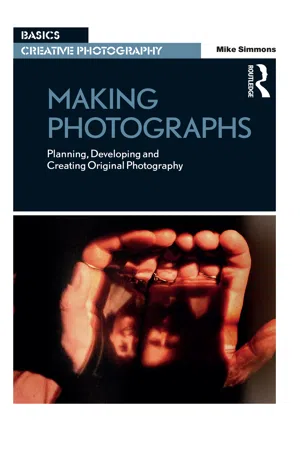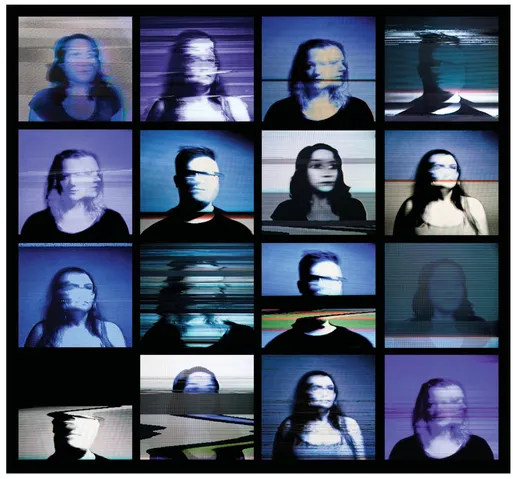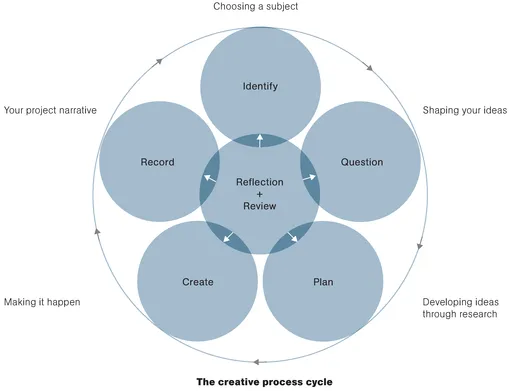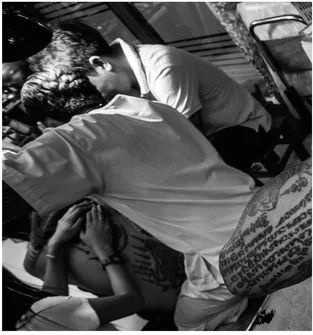
- 176 pages
- English
- ePUB (mobile friendly)
- Available on iOS & Android
eBook - ePub
About this book
This book explores a range of photographic practices, including landscape and portraiture, still life and abstract, and considers techniques such as, directorial photography, photomontage and camera-less photography. With case studies and practical exercises, the reader is introduced to a structured way of developing creative solutions to the work they want to make, fusing personal ideas with knowledge, compositional elements and practical skills. The book enables informed choices to be made about the reader's personal growth as a photographer, contributing to the creation of original photographic work that is informed, meaningful and relevant. Additional reading and resources, on historical and contemporary practices, ideas and techniques, are suggested in each chapter to inspire further enquiry and experimentation.
Frequently asked questions
Yes, you can cancel anytime from the Subscription tab in your account settings on the Perlego website. Your subscription will stay active until the end of your current billing period. Learn how to cancel your subscription.
No, books cannot be downloaded as external files, such as PDFs, for use outside of Perlego. However, you can download books within the Perlego app for offline reading on mobile or tablet. Learn more here.
Perlego offers two plans: Essential and Complete
- Essential is ideal for learners and professionals who enjoy exploring a wide range of subjects. Access the Essential Library with 800,000+ trusted titles and best-sellers across business, personal growth, and the humanities. Includes unlimited reading time and Standard Read Aloud voice.
- Complete: Perfect for advanced learners and researchers needing full, unrestricted access. Unlock 1.4M+ books across hundreds of subjects, including academic and specialized titles. The Complete Plan also includes advanced features like Premium Read Aloud and Research Assistant.
We are an online textbook subscription service, where you can get access to an entire online library for less than the price of a single book per month. With over 1 million books across 1000+ topics, we’ve got you covered! Learn more here.
Look out for the read-aloud symbol on your next book to see if you can listen to it. The read-aloud tool reads text aloud for you, highlighting the text as it is being read. You can pause it, speed it up and slow it down. Learn more here.
Yes! You can use the Perlego app on both iOS or Android devices to read anytime, anywhere — even offline. Perfect for commutes or when you’re on the go.
Please note we cannot support devices running on iOS 13 and Android 7 or earlier. Learn more about using the app.
Please note we cannot support devices running on iOS 13 and Android 7 or earlier. Learn more about using the app.
Yes, you can access Making Photographs by Mike Simmons in PDF and/or ePUB format, as well as other popular books in Art & Art General. We have over one million books available in our catalogue for you to explore.
Information
1
A medium of possibilities

1.0-1.02
Title: From the series By the River Tyne, 2006
Photographer: Alan Duncan
Title: From the series By the River Tyne, 2006
Photographer: Alan Duncan
These eloquent black-and-white images creatively address the impact of social and economic change on the landscape. Once a thriving center of the shipbuilding industry, the legacy of the Tyne's rich industrial past is slowly fading into history.
When it comes to making photographs there are many things to consider; from the kind of equipment you use and the approaches and techniques that are available to you, to the subjects that you are drawn to, and the ways in which you might explore and express your interests through the photographic work you create.
Deciding on that all-important idea for a new project is the first of many challenges that you will encounter as a serious image maker. But ideas are slippery things, which need careful nurturing to help them to develop and be brought to fruition.
Thinking about the work you want to make in a careful and structured way will help you to turn your thoughts into action, and ultimately, into photographs.
The type of equipment you use will make a difference not only to the way that you work, but also in the kind of images that you are able to produce. Alan Duncan's elegiac images of the River Tyne represent a quiet contemplation of what he calls the river's "...rich industrial past," (Duncan 2006) and the area's intimate connection to the photographer's own family's heritage in the North East of England. The images were created using a large format camera, a choice, which Duncan recalls, "...imposed a sense of discipline in observation...and the time and effort it takes to make a picture." The careful consideration of camera viewpoint, subject matter, and the decision to shoot on film and in black and white, has created images with a distinctive mood. The edges of the images, which are the result of using a particular type of instant film, have been included in the final prints as an intentional visual device.
In this case such a mechanism has been used to suggest that these images are not intended as mere documentary record, but have been included to remind the viewer of what Duncan refers to as "...the photographers own subjectivity." The work has been created to echo ".. .the sense of loss of life that the river provided for the local communities," and designed to foster a sense of nostalgia, which Duncan feels for this "...post industrial landscape."
The creative process
The creative process is about you arid the personal journey you make as you work towards the fulfillment of your ideas. It requires you to be curious about the world in which you live, passionate about the way you interpret your observations or experiences, and to some extent obsessive in the way that you tackle and solve the problems that will emerge from your enquiries. It is essential therefore that within your working methods a full range of possibilities and their implications are considered. This will help to broaden your creative horizons, build a framework in which to develop innovative solutions for your ideas, and find your personal voice to express them.
Exploring the nature of dreams, Julia Hadji-Stylianou's work took inspiration from dream theory, which connects the subconscious mind to symbolism, as a method to understand the meaning of dreams. Through her research and experimentation, an idea that began as an exploration of her own dreams using subject matter that reflected the theory, shifted to one that Julia considered"... dreams to have no meaning or order beyond an absurd parallel to everyday life; like the distorted images reflected in a fairground mirror" (Hadji-Stylianou 2013).
'Glitch Art' became the vehicle that was used"... to explore this abstraction more freely." The term 'glitch' was originally used to describe a fault in electrical equipment, but has become a recognized art form, which purposely corrupts analog or digital file data or codes. Using photography, moving image and sound, this new approach allowed greater freedom to explore the subject. It helped to develop a far more spontaneous and unpredictable way of making images, which were suited to the fragmented pattern in which we often remember dreams."
'The limitations in your photography are in yourself'
Ernst Haas (1921-1986).

1.03
Title: Chasing Dreams: Glitched,2013
Photographer: Julia Hadji-Stylianou
Title: Chasing Dreams: Glitched,2013
Photographer: Julia Hadji-Stylianou
This large installation has been created as a back-lit transparency. The images, shot from television screens, explore the nature of dreams and provide an alternative and direct approach to the subject.
Understanding the process
The various stages in the creative process can be conceptualized as a cycle of interrelated activities, which collectively encourage you to push your artistic boundaries by experimenting with tools and materials, encouraging you to explore your subject to gain knowledge and insights, which will inform the decisions that you make about the direction of your work.
Creativity can be a messy process and you may not follow the stages in a linear or logical step-by-step sequence, but in a way that suits your own way of working. Some of the phases you may return to again and again, while others not as often. But your understanding of the work you are making, why and how you are making it, will continue to build as you work towards your goals.
Here the creative process is expressed graphically to illustrate the phases of activity you will engage with in the development of your work. Gradually with experience, this cycle of activity will become second nature as your confidence, experience and skills develop.
"Discovery consists of seeing what everybody has seen and thinking what nobody has thought."
Albert Szent-Györgyi (Good 1962, 28), physiologist

1.04
Title: The Creative Process Cycle The creative process is a cycle of activities. Each one linked to and part of one another. Together they provide a method of working that will help you to develop a critical approach to your photography.
Title: The Creative Process Cycle The creative process is a cycle of activities. Each one linked to and part of one another. Together they provide a method of working that will help you to develop a critical approach to your photography.
Good Water was a project designed to raise awareness of the problem of arsenic pollution in the drinking water," (Grimshaw 2013) in rural villages in Nepal, South Asia. A situation condemned by the World Health Organization"... as the largest mass poisoning of a population in history." The series began as a routine documentary project, photographing the Nepalese villagers who are suffering from long-term health problems, caused by drinking this contaminated water. However, by thinking about the way that photographs can function, and what David observed as the"... resilience, dignity and good humour" of his subjects, he began to experiment with ways to push the idea beyond pure record, into something far more powerful and emotive.
As David has stated: "I seek to strike a balance between telling a story and protecting the identity of individuals, and it became more about the photograph's ability to move us emotionally and to communicate insights about important issues." The work demonstrates how the creative process can help to shape ideas, and take the work you make in different directions, often with surprising results. In order to evolve your ideas effectively, it is important to push yourself creatively; only in this way can you grow as a photographer.


1.05
Title: From the series Good Water, 2013
Photographer: David J. Grimshaw
Title: From the series Good Water, 2013
Photographer: David J. Grimshaw
Layering documentary photographs with specifically created images of water, a link is made between the cause and effect of drinking arsenic polluted water in a far stronger and compelling way than the single documentary images alone could do.
Choosing a subject

There is often a tendency for photographers to work backwards from a pre-established view of the finished work. In other words, from expectation driven by the premise of 'this project will be...' However, such an approach may limit the potential for your Ideas. By turning this scenario around, a far better strategy would be to ask the question 'what might the possibilities be for my idea?' In this way you open the door to experimentation rather than limitation in finding the most appropriate solutions for the development of your ideas. By brea...
Table of contents
- Cover
- Title Page
- Copyright Page
- Contents
- Introduction
- 1 A medium of possibilities
- 2 Understanding your subject
- 3 Exploring photographic genres
- 4 Making photographs
- 5 Managing your project
- 6 Completing your project
- Conclusion
- Bibliography
- Webography
- References
- Index
- Picture credits
- Acknowledgements